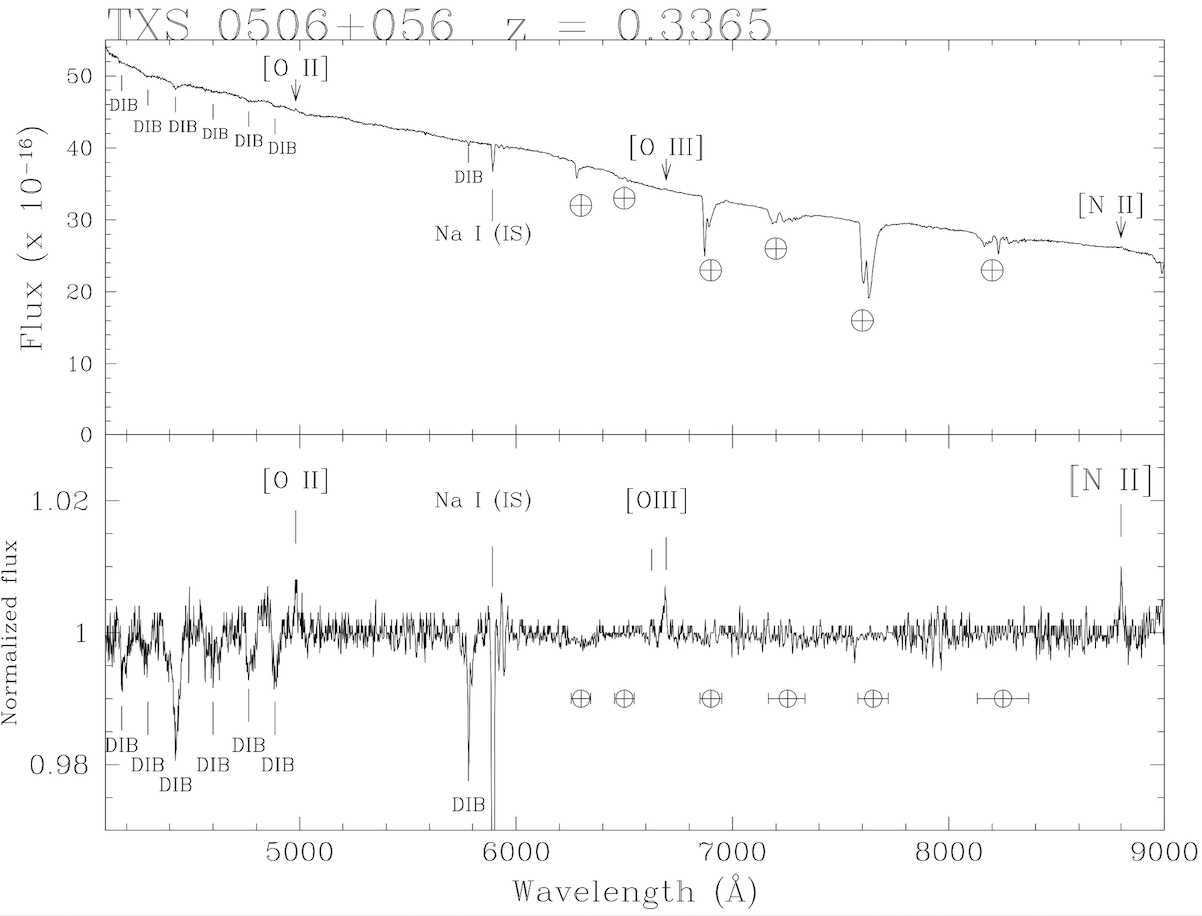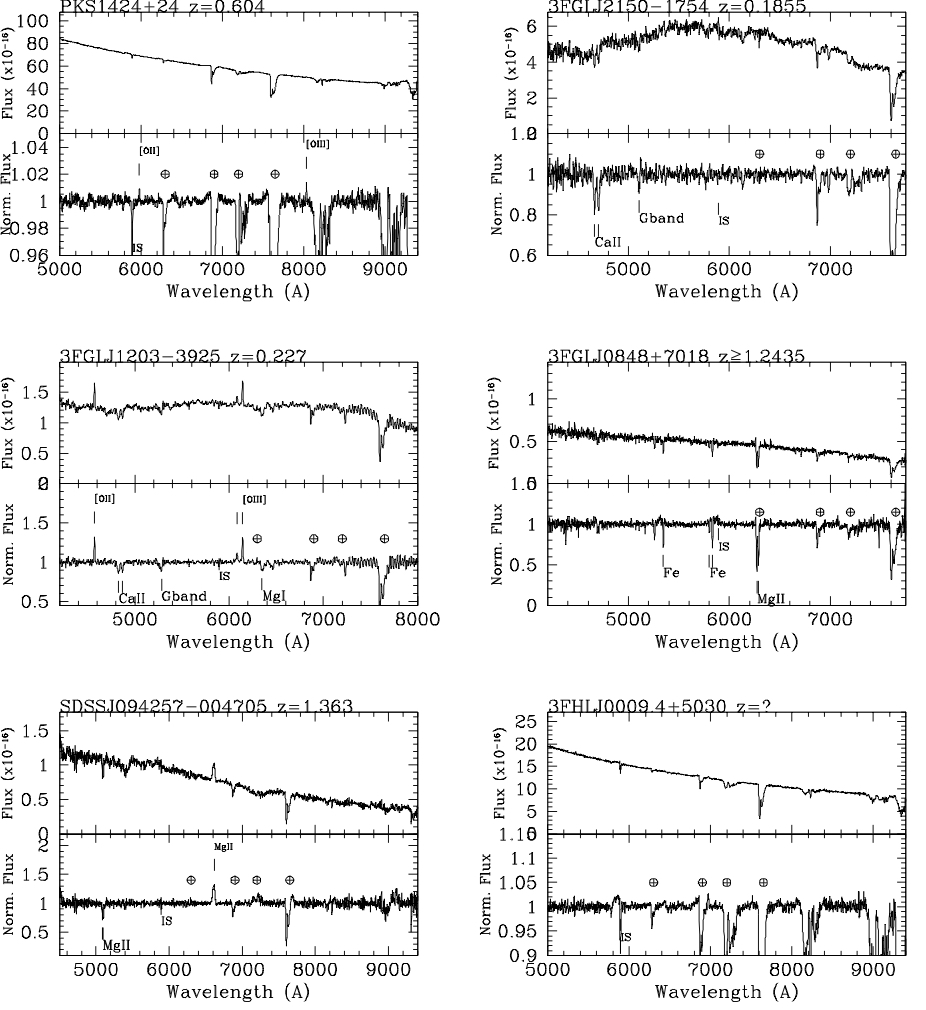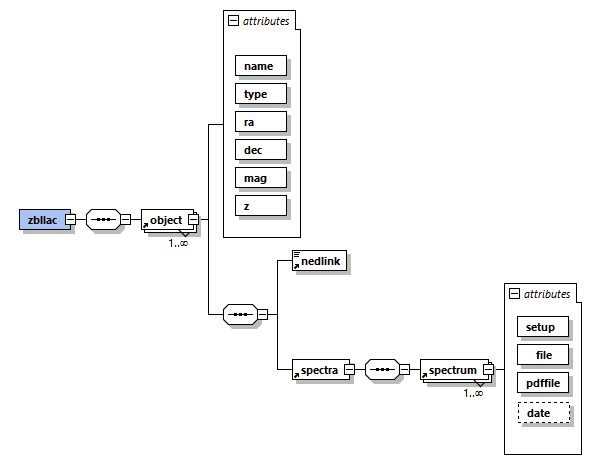Introduction
BL Lacertae (BLL) are a peculiar class of low power (~ 1043 erg/sec) Active Galactic Nuclei (AGN) whose relativistic jet, generated by the accretion of matter onto a supermassive black hole, is closely aligned with the observer's line of sight (Blandford & Rees 1978). In this condition, the radiation produced by the jet is boosted due to the relativistic Doppler aberration, and typically dominates the Spectral Energy Distribution (SED) at almost any wavelength of the electromagnetic spectrum (see e.g. Ghisellini et al., 1993). A peculiar characterstic of BLL is that, in this kind of objects, emission lines are absent or extremely weak as shown in Figure 1 (see e.g. Falomo et al 2014 for a recent review) and the boosted non-thermal continuum, in most of the cases, outshines the contribution from the starlight of the host galaxy (Figure 2), which is typically a giant Elliptical with Mv = -22.50 (Sbarufatti et al 2005). The quasi-featureless continuum exhibited by BLL is a characteristic that made them rather elusive since the determination of the redshift, which is a fundamental parameter to determine the distance and derive physical quantities, is in many cases hindered. More generally, BLL are a subclass of a larger parent population called Blazars, which encompass also more powerful sources (namely Flat Spectrum Radio Quasars, FSRQ) with bolometric luminosity of the order of 1047, 1048 erg/sec and optical spectra characterized by broad emission lines, suggesting the presence of radiatively efficient accretion disk (e.g. Shakura-Sunyaev 1973).

Figure 1: The optical spectrum of the neutrino counterpart TXS 0506+056. The spectrum can be downloaded in electronic form from ZBLLAC |

Figure 2: BL Lacs host galaxies. Systematic imaging study was performed by the HST through a snapshot survey of more that 100 objects using WFPC2. For more information check this work. |
Many surveys from radio to gamma-rays allowed to increase the sample of known candidate BLLs, stimulating spectroscopical follow up in the optical band, that were carried out with different telescopes and instrumentations. However, only the observations of these objects with large aperture optical telescope (like the Very Large Telescope, Keck Telescope and Gran Telescopio CANARIAS) equipped with state-of-the-art instrumentation could allow to secure sufficiently high signal-to-noise ratio spectra and reveal weak spectral lines (intrinsic or intervening) to firmly determine the redshift of the object (e.g. Sbarufatti et al 2006, Shaw et al 2014, Paiano et al 2017).
Although the results of these observational efforts are frequently summarised across catalogues in the literature (e.g. Roma BZCat, TevCAT) none of them allow to access the fully calibrated spectra of the sources among with an homogeneous set of figures that permit to identify the spectral features detected in the spectra and then reuse the data for many different scientifical aims. Aiming to fill this gap, we developed ZBLLAC, a new web-based database of BL Lac objects able to act as an online hub where optical spectra secured in the context of different publications with heterogeneous instrumentation are stored and made available to the community.
The ZBLLAC spectroscopic database
ZBLLAC contains spectra for 337 BLL candidates objects. According to the appearance of their optical spectra stored in our database, such as the absenceof spectral features or, when emission lines are detected, on the basis of their luminosity and broadness 41 targets were reclassified. We consider 295 sources as genuine BLL.
For each object in ZBLLAC we give coordinates (RA, DEC in J2000) catalog name, redshift, magnitude and provide a flux calibrated spectrum, dereddened for Galactic extinction. Spectra are available both in text format and with a PDF figure which reports both the flux calibrated and normalized spectra. The main detected features, if present, are marked and identified (see example of Figure 3). For 37 BLLs more than one spectrum, secured in different epochs and with different instrumentation,is reported in the database.

|
Figure 3: Examples of spectra contained in the ZBLLAC database. Data can be retrieved both in txt and PDF format. |
The database can be accessed through the Spectroscopic Database page . Sources classified as BLL are identified with the label B in the columun Type.
The data model
Data in ZBLLAC are stored using the eXtensible Markup Language standard that combines the possibility to easy query the database while being both machine and human readable. More specifically, the XML is a markup language that defines a set of rules for encoding plain-text documents in which the data are marked by tags or attributes. Data within XML documents are organized using a tree-like data structure, where each node may possesses one or more leafs.

|
Figure 4: Schematic of the XML-based database adopted for the ZBLLAC database. |
We adopted the XML scheme in Figure 4 to store our data by using the XML. The root node of the data structure is zbllac which contains, as leafs, the set of all object of ZBLLAC database. Each object (see Figure 3) contains as attributes all the relevant information to identify the source (name, coordinates, etc.) and two mores nodes: the first one, named nedlink, contains the link to the object's NED page while the second (spectra) harbors a set of spectrum nodes where the information about each observation and the relative HTTP links to download the data are saved.
The XML database file can be downloaded HERE!
Do you want to contribute ?
The ZBLLAC spectroscopic database is an ongoing and still growing project. At the date of last update, we collected spectra for more than 340 objects and we are continuously enriching it with new data published by either our groups and other teams that joined our project.
We are indeed encouraging other groups to contribute to ZBLLAC by sharing their own published data secured during spectroscopical campaign targeted to blazars. To contribute to ZBLLAC, we require authors to send us data following these instructions!
We are indeed encouraging other groups to contribute to ZBLLAC by sharing their own published data secured during spectroscopical campaign targeted to blazars. To contribute to ZBLLAC, we require authors to send us data following these instructions!